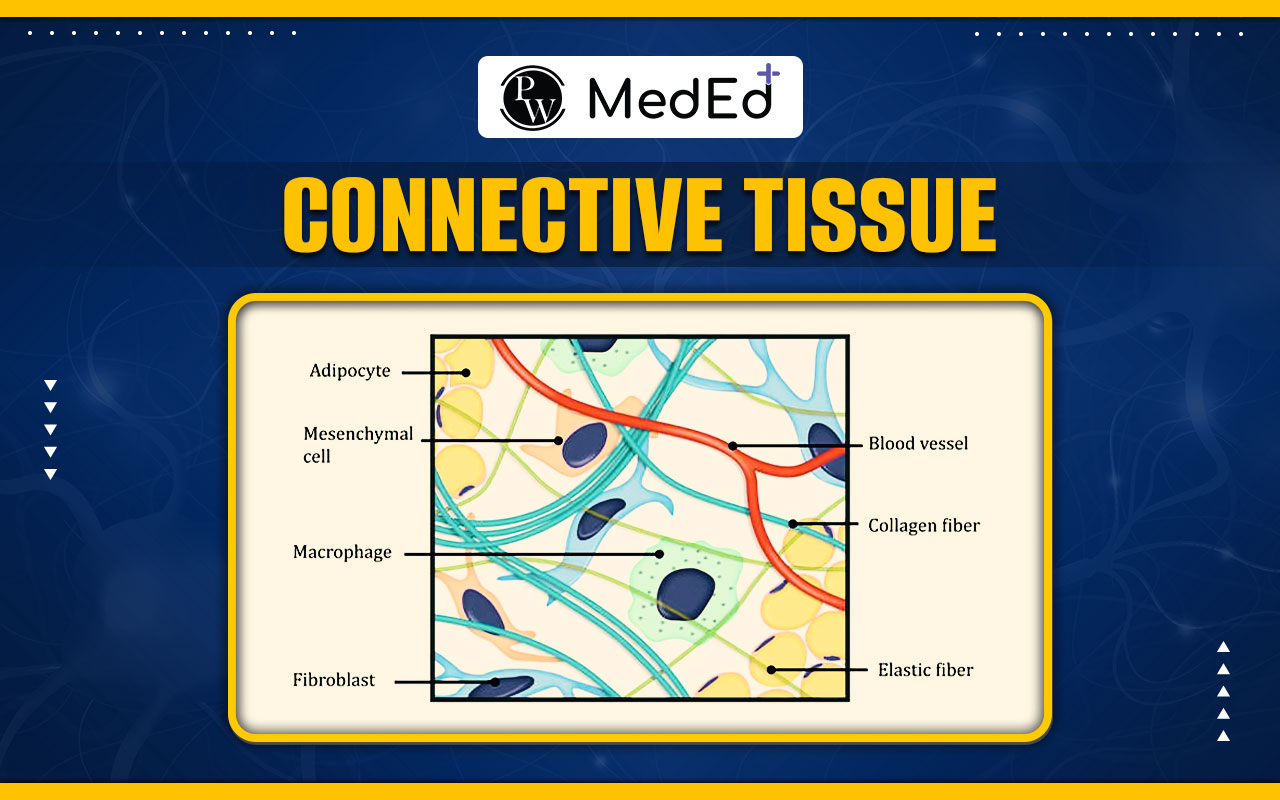

Types Of Connective Tissue
Based on the cells present and the extracellular matrix structure, connective tissue is divided into two types: connective tissue proper and specialized connective tissue. Connective tissue proper is further divided into loose connective tissue and dense connective tissue.Loose Connective Tissue
Loose connective tissue, also known as areolar connective tissue, contains nearly equal amounts of cells, fibers, and ground substance. The primary cells in this type of tissue are fibroblasts. Both collagen and elastic fibers are present in this type of connective tissue. It is the most widely distributed tissue in the body. Examples include the lamina propria of the digestive and respiratory tracts. Its major role is in binding other tissues together.Dense Connective Tissue
Dense connective tissue is further divided into dense irregular and dense regular connective tissue.Dense Regular Connective Tissue:
Dense regular connective tissue is characterized by collagen fibers that run parallel to one another. This specific alignment allows the tissue exceptional strength when subjected to stress from a single direction. Prime examples of dense regular connective tissue include tendons, which connect muscles to bones, and ligaments, which connect bones to each other. They play crucial roles in stabilizing joints and facilitating movement.Dense Irregular Connective Tissue:
Dense irregular connective tissue consists of collagen fibers that are connected in a random manner, providing resistance to stretching in all directions. This type of tissue is typically found in the capsules and walls of various organs, the dermis of the skin, and around glands. Additionally, dense irregular connective tissue contains fewer cells and ground substance compared to loose connective tissue, and its robust structure aids in protecting and supporting organs. It also plays a crucial role in the structural integrity and flexibility of the skin, making it vital for maintaining skin resilience and elasticity.Specialized Connective Tissue
Specialized connective tissue plays an important role in maintaining proper posture and supporting internal organs. Examples include fluid connective tissue such as blood and lymph. Bone and cartilage are other examples of specialized connective tissue.Bone
Bone is the hardest connective tissue, essential for maintaining the body’s shape and posture and protecting internal organs. Bones are rich in collagen fibers and calcium, which confer strength and rigidity. Bone cells, known as osteocytes, are located in lacunae and secrete the bone matrix. The central marrow cavity of bones contains spongy tissue known as marrow. Yellow marrow stores fat, while red marrow is responsible for producing blood cells.Cartilage
Cartilage is mainly found during embryonic development, serving as a supportive skeleton. In adults, most cartilage is replaced by bone. However, it is present in adults at certain places such as the intervertebral discs, external ear, nose, and joints. The primary cells in cartilage are chondrocytes. The chondrocytes are present in a firm, rubbery matrix which is secreted by the chondrocytes themselves. This matrix contains collagen fibers, which enhance its strength. Cartilage is an avascular structure. There are three types of cartilage: hyaline cartilage, elastic cartilage, and fibrocartilage.Fluid Connective Tissue
Blood
Blood is a specialized connective tissue composed of plasma and formed elements. The cells in the blood are RBCs, WBCs, and platelets. Different types of cells have various functions in the body. Plasma, the fluid component of blood, contains proteins, water, hormones, salts, and other substances that are transported to various parts of the body.Lymph
Lymph is another fluid connective tissue besides blood. It contains a liquid matrix with white blood cells, which help eliminate toxins and waste materials and fight infections.Connective Tissue FAQs
What are the three types of cartilage, and where are they typically found?
Cartilage is of three types:
•Hyaline cartilage: Found on the articular surfaces of joints, walls of the upper respiratory airways, and medial ends of the ribs.
•Elastic cartilage: Found in the walls of the external ear, epiglottis, and cuneiform cartilage of the larynx.
•Fibrocartilage: Found in articular discs, such as the intervertebral discs, pubic symphysis, and knee menisci.
Why is blood regarded as a specialized connective tissue?
Connective tissue is a major supporting tissue in the body that provides structural framework and support to various tissues. Blood is considered a connective tissue because it circulates throughout the body, facilitating communication and interaction among different organs and tissues.
What are the two main types of connective tissue based on the cells present and ECM structure, and what is the difference between their composition?
The primary cells in loose connective tissue are fibroblasts. This tissue contains both collagen and elastic fibers. Connective tissue proper contains a variety of cells, such as fibroblasts, macrophages, and adipocytes, and a diverse extracellular matrix with collagen and elastic fibers, whereas specialized connective tissue contains specific types of cells and a distinct extracellular matrix tailored to their unique functions.
What is mixed connective tissue disease?
Mixed connective tissue disease (MCTD) is a rare autoimmune condition identified by the presence of a specific antibody called anti-U1-ribonucleoprotein. It shows symptoms of at least two connective tissue disorders, such as SLE and rheumatoid arthritis.
Talk to a counsellorHave doubts? Our support team will be happy to assist you!

Check out these Related Articles
Free Learning Resources
PW Books
Notes (Class 10-12)
PW Study Materials
Notes (Class 6-9)
Ncert Solutions
Govt Exams
Class 6th to 12th Online Courses
Govt Job Exams Courses
UPSC Coaching
Defence Exam Coaching
Gate Exam Coaching
Other Exams
Know about Physics Wallah
Physics Wallah is an Indian edtech platform that provides accessible & comprehensive learning experiences to students from Class 6th to postgraduate level. We also provide extensive NCERT solutions, sample paper, NEET, JEE Mains, BITSAT previous year papers & more such resources to students. Physics Wallah also caters to over 3.5 million registered students and over 78 lakh+ Youtube subscribers with 4.8 rating on its app.
We Stand Out because
We provide students with intensive courses with India’s qualified & experienced faculties & mentors. PW strives to make the learning experience comprehensive and accessible for students of all sections of society. We believe in empowering every single student who couldn't dream of a good career in engineering and medical field earlier.
Our Key Focus Areas
Physics Wallah's main focus is to make the learning experience as economical as possible for all students. With our affordable courses like Lakshya, Udaan and Arjuna and many others, we have been able to provide a platform for lakhs of aspirants. From providing Chemistry, Maths, Physics formula to giving e-books of eminent authors like RD Sharma, RS Aggarwal and Lakhmir Singh, PW focuses on every single student's need for preparation.
What Makes Us Different
Physics Wallah strives to develop a comprehensive pedagogical structure for students, where they get a state-of-the-art learning experience with study material and resources. Apart from catering students preparing for JEE Mains and NEET, PW also provides study material for each state board like Uttar Pradesh, Bihar, and others
Copyright © 2025 Physicswallah Limited All rights reserved.
Get App










